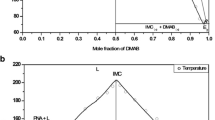Abstract
Equimolar complex formation of either urea or thiourea with 2-ethoxy-benzamide (2-EB) and 2-methoxy-benzamide (2-MB) was investigated. Complex formation of urea and 2-MB was observed both by co-grinding method and by coprecipitation method. Molecular arrangement of the complex was determined by single crystal X-ray diffraction method as an equimolar complex. The crystal structure of the urea-2-MB complex, especially hydrogen bond networks, was quite different from that of thiourea-2-MB complex. In urea-2-MB equimolar complex, not only intermolecular hydrogen bond between urea and 2-MB but also hydrogen bond network between urea molecules played important roles to form the complex. When urea was co-ground with 2-EB, equimolar complex formation was not observed. Conformational change of guest molecules by the complexation was investigated in terms of intramolecular hydrogen bond length and the dihedral angles. Reduction of intramolecular hydrogen bond length of 2-MB and the conformational change to the flatter structure affected the equimolar complex formation.
Similar content being viewed by others
References
P. Jara J. Merchan N. Yutronic G Gonzalez (2000) ArticleTitleabcd J. Incl. Phenom. Macro 36 101 Occurrence Handle1:CAS:528:DC%2BD3cXhsFCqs70%3D
(a) : J. Mol. Graph. 13, 138 (1995). (b) K.D.M. Harris: J. Mol. Struct. 374, 241 (1996).
K. Takemoto N Sonoda (1984) Inclusion Compounds of Urea, Thiourea and Selenourea J.L. Atwood J.E.D. Davies D.D. MacNicol (Eds) Inclusion Compounds NumberInSeriesVol. 2 Academic Press London
N. Yutronic V. Manriquez P. Jara O. Witke J. Merchán G González (2000) ArticleTitleabcd J. Chem. Soc. Perkin Trans 2 1757
M. Brandstätter A Burger (1997) ArticleTitleabcd J. Therm. Anal 50 559
C.C. Rusa C. Luca A.E. Tonelli M Rusa (2002) Polymer 43 3969 Occurrence Handle10.1016/S0032-3861(02)00225-2 Occurrence Handle1:CAS:528:DC%2BD38XjtlKltr4%3D
K.D.M. Harris J.M.J Thomas (1990) Chem. Soc. Faraday Trans 86 1095 Occurrence Handle1:CAS:528:DyaK3cXkslOgur0%3D
G.H. Penner J.M. Polson C. Stuart G. Ferguson B.J Kaitner (1992) ArticleTitleabcd J. Phys. Chem 96 5121 Occurrence Handle10.1021/j100191a068 Occurrence Handle1:CAS:528:DyaK38XkvVajtLc%3D
M.D. Hollingsworth B.D. Santarsiero H. Oumar-Mahamat C.J Nichols (1991) Chem. Mater 3 23 Occurrence Handle10.1021/cm00013a010 Occurrence Handle1:CAS:528:DyaK3MXnt1ClsQ%3D%3D
V Videnova-Adrabińska (1996) J. Mol. Struct 374 199
Y. Hishikawa, K. Sada, and M. Miyata: J. Chem. Res. (S), 738 (1998).
S. Lee B.M. Kariuki A.L. Richardson K.D.M Harris (2001) J. Am. Chem. Soc 123 12684 Occurrence Handle1:CAS:528:DC%2BD3MXotlKrsbw%3D
T. Oguchi K. Kazama E. Yonemochi S. Chutimaworapan W.S. Choi S. Limmatvapirat K Yamamoto (2000) Phys. Chem. Chem. Phys 2 2815 Occurrence Handle10.1039/b001644f Occurrence Handle1:CAS:528:DC%2BD3cXjslWks7s%3D
K. Moribe R. Mochizuki Y. Tozuka T. Uchino T. Fukami T. Oguchi K Yamamoto (2004) J. Jpn. Soc. Pharm. Mach. & Eng 13 5
K. Moribe M. Tsuchiya Y. Tozuka K. Yamaguchi T. Oguchi K Yamamoto (2004) Chem. Pharm. Bull 52 524 Occurrence Handle10.1248/cpb.52.524 Occurrence Handle1:CAS:528:DC%2BD2cXksVylt7k%3D
A. Altomare M.C. Burla M. Camalli G.L. Cascarano C. Giacovazzo A. Guagliardi A.G.G. Moliterni G. Polidori R Spanga (1999) J. Appl. Cryst 32 115 Occurrence Handle1:CAS:528:DyaK1MXhsFOrsbo%3D
P.T. Beurskens G. Admiraal G. Beurskens W.P. Bosman R. de Gelder R. Israel R. Israel J.M.M. Smits (1994) Technical Report of the Crystallography Laboratory University of Nijmegen The Netherlands
G. Smith K.E. Baldry K.A. Byriel C.H.L Kennard (1997) Aust. J. Chem 50 727–736 (1997) Occurrence Handle1:CAS:528:DyaK2sXmtV2ju70%3D
M.M. Elcombe J.C Taylor (1968) Acta Crystallogr. A 24 410–420 Occurrence Handle10.1107/S0567739468000835 Occurrence Handle1:CAS:528:DyaF1cXktlWisb0%3D
Author information
Authors and Affiliations
Corresponding author
Rights and permissions
About this article
Cite this article
Moribe, K., Tsuchiya, M., Tozuka, Y. et al. Equimolar Complex Formation of Urea or Thiourea with 2-alkoxy-benzamides: Structural Factors Required for the Equimolar Complex Formation. J Incl Phenom Macrocycl Chem 54, 9–16 (2006). https://doi.org/10.1007/s10847-005-3183-4
Received:
Accepted:
Issue Date:
DOI: https://doi.org/10.1007/s10847-005-3183-4



